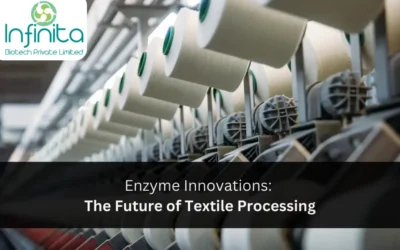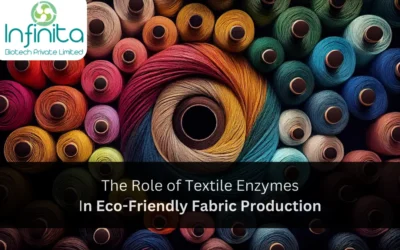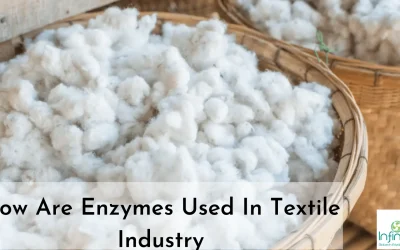Textile Enzymes manufacturing is a significant industry worldwide, but it is also notorious for its negative environmental impact. The use of traditional chemicals in textile processing leads to water pollution, energy consumption, and a high carbon footprint. However, there is a greener alternative that can revolutionize the textile industry – desize enzymes. These enzymes offer numerous environmental advantages over traditional manufacturing practices, making them an excellent solution for sustainable textile production.
Understanding Desize Enzymes
Before delving into the environmental advantages of desize enzymes, it is crucial to understand what they are and how they function. Desize enzymes are naturally occurring biocatalysts that break down starch materials commonly found in textiles. They play a critical role in the textile manufacturing process by removing the sizing agents applied to yarns and fabrics.
What are Desize Enzymes?
Desize enzymes, also known as desizing enzymes or amylase enzymes, are a subgroup of enzymes classified as hydrolases. They belong to the alpha-amylase family and are derived from various microorganisms, such as bacteria and fungi. These enzymes catalyze the hydrolysis of starch into soluble carbohydrates, facilitating their removal from textiles during desizing.
The Role of Desize Enzymes in Textile Manufacturing
Desize enzymes play a vital role in textile manufacturing by breaking down the starch-based sizing agents used to strengthen or stiffen yarns and fabrics. Sizing agents provide structure to the textile during the weaving or knitting process and are typically applied to improve handling, reduce breakages, and prevent yarn abrasion. However, these agents are not desired in the final product and must be removed before further processing.
Traditionally, the removal of sizing agents required the use of harsh chemicals and extensive water rinsing. This outdated approach not only affects the quality of the final product but also poses significant environmental and health risks.
Alternatively, desize enzymes offer an efficient and eco-friendly solution to remove sizing agents. These enzymes selectively target and degrade the starch present in sizing agents, allowing for their easy removal without compromising textile quality. Furthermore, desize enzymes operate under mild reaction conditions, reducing the need for excessive energy consumption.
In addition to their environmental advantages, desize enzymes also contribute to improved textile production efficiency. The use of these enzymes eliminates the need for prolonged rinsing and reduces the overall processing time. This not only saves valuable resources but also increases the productivity of textile manufacturers.
Moreover, desize enzymes are highly specific in their action, targeting only the starch-based sizing agents and leaving the textile fibers unharmed. This specificity ensures that the fabric’s integrity and quality are maintained throughout the desizing process.
Furthermore, the use of desize enzymes in textile manufacturing promotes sustainability by minimizing the release of harmful chemicals into the environment. The enzymatic desizing process significantly reduces the discharge of toxic substances, such as formaldehyde and chlorine, which are commonly used in traditional desizing methods.
Overall, desize enzymes offer a greener and more efficient alternative to remove sizing agents from textiles. With their ability to break down starch materials, their mild reaction conditions, and their contribution to sustainable manufacturing practices, desize enzymes are revolutionizing the textile industry.
The Environmental Impact of Traditional Textile Manufacturing
Traditional textile Enzymes manufacturing relies heavily on the use of chemicals and large quantities of water. While these practices have enabled mass production, they come at a considerable environmental cost. Understanding the environmental impact of conventional textile manufacturing is crucial in appreciating the benefits of adopting desize enzymes as a green alternative.
The Chemicals Used in Traditional Textile Manufacturing
In traditional textile manufacturing, a wide array of chemicals, including bleach, alkalis, acids, and petroleum-based solvents, is employed for various processes such as dyeing, finishing, and sizing. These chemicals are often toxic and pose serious risks to human health and the environment. Moreover, their production and disposal contribute to air and water pollution, soil contamination, and depletion of natural resources.
The Environmental Consequences of Chemical Use
The widespread use of chemicals in textile manufacturing results in several detrimental environmental consequences. Water pollution is a primary concern, as the discharge of chemical-laden wastewater into rivers and oceans leads to ecosystem disruption and the loss of aquatic life. Additionally, the energy-intensive nature of traditional manufacturing processes contributes to carbon emissions and exacerbates climate change.
Moreover, the production and disposal of chemical waste generate significant amounts of hazardous byproducts that can contaminate soil and groundwater. This contamination, in turn, affects ecosystems, agricultural productivity, and public health.
Furthermore, the environmental impact of traditional textile manufacturing extends beyond chemical use. The excessive water consumption in these processes is a significant concern. It takes an enormous amount of water to dye, wash, and rinse textiles, leading to water scarcity in regions where textile manufacturing is prevalent.
In addition to water scarcity, the energy requirements of traditional textile manufacturing contribute to the depletion of fossil fuel resources. The machinery used in these processes relies heavily on non-renewable energy sources, further contributing to the carbon footprint of the industry.
Furthermore, the disposal of textile waste poses a significant challenge. The fast fashion industry, which relies on mass production and quick turnover, generates a staggering amount of textile waste that often ends up in landfills. These textiles can take hundreds of years to decompose, contributing to the growing problem of waste management and landfill overcrowding.
Recognizing the environmental impact of traditional textile manufacturing is crucial in driving the adoption of sustainable alternatives. By embracing innovative technologies and practices, such as desize enzymes and water recycling systems, the textile industry can significantly reduce its ecological footprint and move towards a more sustainable future.
The Green Alternative: Desize Enzymes
Recognizing the environmental impact of traditional textile Enzymes manufacturing, industry leaders and researchers have increasingly turned to desize enzymes as a sustainable alternative. Desize enzymes offer several notable advantages that make them an appealing choice for eco-conscious textile manufacturers.
How Desize Enzymes Work
Desize enzymes work by breaking down the starch-based sizing agents into smaller, soluble molecules. The enzymes bind to the starch and initiate a chemical reaction that hydrolyzes the starch molecules, ultimately converting them into simpler carbohydrates. These smaller molecules can then be easily washed away, leaving behind a clean and starch-free textile without the need for harsh chemicals.
The Benefits of Using Desize Enzymes in Textile Manufacturing
The use of desize enzymes in textile manufacturing comes with numerous benefits. Firstly, it drastically reduces the need for harmful chemicals, thereby minimizing the risk of water pollution and human health hazards. Desize enzymes offer a more sustainable and safer approach to desizing, ensuring a healthier working environment for textile industry workers.
Furthermore, desize enzymes are highly efficient, requiring lower temperatures and shorter reaction times compared to traditional desizing methods. This results in substantial energy savings and a notable reduction in carbon emissions. Additionally, using enzymes avoids the formation of toxic byproducts, contributing to a cleaner and greener textile production chain.
The Environmental Advantages of Desize Enzymes
The adoption of desize enzymes in textile manufacturing brings several significant environmental advantages. These advantages serve as a compelling case for transitioning towards a more sustainable and eco-friendly textile industry.
Reduction in Water Pollution
Desize enzymes offer a direct solution to the water pollution caused by traditional textile manufacturing practices. By eliminating the need for harsh chemical treatments and excessive water rinsing, enzymes substantially reduce the levels of chemical pollutants discharged into water bodies. This reduction in water pollution helps preserve aquatic ecosystems and minimizes the adverse impacts on human and environmental health.
Decrease in Energy Consumption
Another notable environmental advantage of desize enzymes is the decrease in energy consumption. As work efficiently under milder reaction conditions, lower temperatures and shorter process times are required. This reduction leads to significant energy savings and a corresponding decrease in carbon emissions. By adopting desize enzymes, textile manufacturers can contribute to mitigating climate change and achieving energy efficiency targets.
Lowering Carbon Footprint
Traditional textile manufacturing processes account for substantial carbon emissions, primarily due to their reliance on energy-intensive operations and chemical-based treatments. In contrast, desize enzymes offer a much greener alternative with a significantly lower carbon footprint. By minimizing energy usage and eliminating chemical waste, desize enzymes contribute to a cleaner and more sustainable production process, mitigating the overall carbon impact of textile manufacturing.
The Future of Textile Manufacturing with Desize Enzymes
The future of textile manufacturing lies in embracing sustainable practices, and desize enzymes represent a significant advancement in this direction. However, several challenges exist in implementing desize enzymes on a large scale. Addressing these challenges is crucial to fully unlock the potential of these enzymes in sustainable textile manufacturing.
Challenges and Solutions in Implementing Desize Enzymes
One key challenge in implementing desize enzymes is the need for optimized enzyme formulas and efficient application methods. Textile manufacturers must find the right enzyme formulations that cater to specific textile materials and processing conditions. Additionally, developing cost-effective enzyme application techniques and integrating them into existing manufacturing processes requires careful engineering and research.
Moreover, educating textile industry stakeholders about the environmental and economic benefits of desize enzymes is essential. Raising awareness and fostering collaboration between enzyme producers, textile manufacturers, and regulatory bodies can support a smooth transition towards incorporating these enzymes into mainstream textile production.
The Potential of Desize Enzymes in Sustainable Textile Manufacturing
Despite the challenges, desize enzymes hold immense potential for driving sustainable textile manufacturing. As the textile industry continues to face growing pressure to reduce its environmental impact, enzymes offer a practical and effective solution. By harnessing the power of nature, desize enzymes pave the way for a greener, cleaner, and more sustainable future for textile manufacturing.
Overall, desize enzymes offer a promising alternative to traditional textile manufacturing methods. Their environmental advantages, including reductions in water pollution, energy consumption, and carbon footprint, make them an excellent tool for achieving sustainable textile production. As the industry embraces greener practices, desize enzymes will play a crucial role in transforming textile manufacturing into a more environmentally friendly and socially responsible sector.







